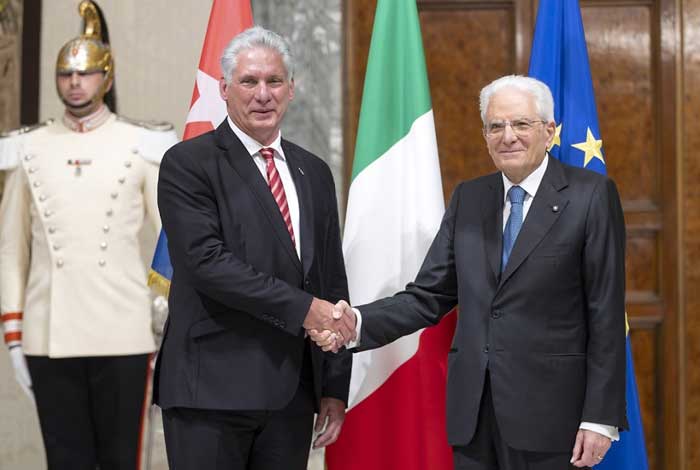
Cuban President Miguel Díaz-Canel arrived in Italy on June 19 for a two-day visit that included a meeting with Head of State Sergio Mattarella and an audience with Pope Francis at the Vatican.
Rome.- Since his arrival at the Leonardo Da Vinci (Fiumicino) airport in Rome at 2:10 p.m., local time, on that day, the Cuban president fulfilled a busy work agenda that also included a meeting with Qu Dongyu, general director of the United Nations Food and Agriculture Organization (FAO).
Díaz-Canel also met Italian business people on the afternoon of June 20 and concluded his visit with an emotional meeting with members of solidarity groups, Cubans residents in Italy, and officials from the Cuban Embassy in Rome.
The Cuban delegation also included Foreign Minister Bruno Parrilla, First Deputy Foreign Trade and Foreign Investment Minister Ana Teresita González, and the head of the Department of Religious Affairs at the Central Committee of the Communist Party of Cuba, Caridad Diego.
Other members of the delegation were Deputy Foreign Ministers Anayansi Rodríguez, Carlos Fernández de Cossío, and Elio Rodríguez, as well as the director of Europe and Canada Department at the Foreign Ministry, Gisela García, and Ambassadors to Italy and the Holy See Mirta Granda and René Mujica, respectively.
The private audience with the Supreme Pontiff began at 10:00 a.m., local time, on June 20, in the Paul VI Hall of the Vatican, the same place where Francis received then-Cuban President Raúl Castro in May 2015.
“It was a frank conversation,” Díaz-Canel wrote later in a message on Twitter, adding that “We confirm broad coincidences on pressing issues on the international agenda for humanity,” as well as “the current Cuban reality, particularly the severe impact of the intensified economic blockade by the United States on our population.”
I appreciated his expressions of closeness and encouragement in favor of our country,” tweeted the president, who told Pope Francis about his will “to continue to strengthen relations between both States.”
As gifts “on behalf of the people of Cuba, he presented the Holy Father with two texts by poets Cintio Vitier and Fina García Marruz, who were married and were committed Catholics and founding figures of the best tradition of Cuban intelligentsia, as well as a sculpture entitled “Reader,” made by Miguel Ángel Martínez.
Pope Francis gave the Cuban head of State a bronze dove carrying an olive branch, with the inscription “Be messengers of peace,” in addition to the book on the Statio Orbis of March 27, 2020, and this year’s Message for Peace.
After meeting the Pope, Díaz-Canel met with the Secretary of State Cardinal Pietro Parolin, and “we agreed to highlight satisfactorily the positive development of relations between Cuba and the Holy See” and “we ratify the will to continue to strengthen them,” the Cuban leader asserted in another tweet.
At noon on Tuesday, the president had a working lunch with representatives of the Italian business community that, according to what he said, “has not stopped and has maintained its cooperation and exchanges with Cuba,” and continues to participate in the main programs, at a very important time for economic and commercial relations.
Díaz-Canel underscored Italy’s willingness to consider Cuba a prioritized country for collaboration and “we know the conditions under which you have firmly maintained relations with Cuba, which is more attacked, more besieged, with a tightened blockade,” he acknowledged.
Díaz-Canel also assessed the proper functioning of the bilateral business commission and the Italy-Cuba investment committee, and spoke about Cuba’s current economic policy to promote foreign investment, with actions such as the opening of wholesale and retail trade to it.
He informed that the first business of this kind will be precisely with the Italian company Farmavenda, and noted the presence in Cuba of fifty business representations from Italy, and the development of various businesses in the Mariel Special Development Zone(ZEDM).
On the afternoon of June 20, the meeting between Díaz-Canel and his Italian counterpart, Sergio Mattarella, took place at the Quirinale Palace, where both leaders reaffirmed their willingness to continue to develop bilateral ties in areas of mutual interest.
In particular, economic-commercial relations were assessed, as well as cooperation in the fields of culture, health care, and other sectors, and the common will to continue to consolidate the historic relations established 120 years ago, on February 4, 1903, was ratified.
At the meeting with Mattarella, Díaz-Canel acknowledged the importance and value that Cuba grants to Italy’s historic stance against the economic, commercial, and financial blockade imposed on his country by the Government of the United States.
The contact with the Italian president was followed by a meeting with Qu Dongyu, at the FAO headquarters, to whom Díaz-Canel expressed “eternal gratitude for the unconditional and permanent support for Cuba,” and extolled the implementation of the National Food Sovereignty and Nutritional Education Plan, with the help of that United Nations agency.
“We have also been working on the development of sustainable agriculture and food production systems,” amid Cuba’s current conditions, due to the US blockade.
“FAO can always count on our country’s support,” the Cuban president wrote in the visitors’ book at the end of the meeting.
A few hours before leaving Italy for Serbia, at 6:00 p.m., local time, on June 20, the president held an emotional meeting with Cuban diplomatic personnel, as well as compatriots who reside here and members of friendship groups, whom he thanked for their support and solidarity for his country.
Díaz-Canel concluded the first stage of his European tour, which also includes France, where he will participate, as president of the G77+China, in the Summit for a new World Financial Pact, to be held in Paris, on June 22 and 23. (PL)